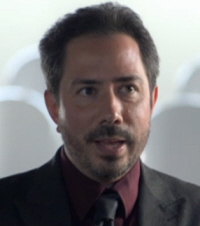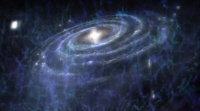Stretching the Universe
Anthony Aguirre, Janna Levin
Horizon - How BIG is the Universe?

Anthony Aguirre
Anthony Aguirre, from the University of California in Santa Cruz, is a theoretical cosmologist. So he's used to thinking big.
Professor Anthony Aguirre "Now to say that we're going to go out and make a map of universe, it almost sounds crazy. It sounds like the real hubris,
right? And yet the universe, as it turns out, is really amenable to mapping."
But you have to think big, and clever. And that's where the balloons come in. Because the map of the universe isn't like other maps.
Anthony Aguirre "We have to think in a different way. We can't just go out and look at the universe and draw things on paper and say, 'There's our
map of the universe'."
The universe is so big that the laws of physics say we can't see all of it. It's as if we're at the centre of a giant balloon, and we can't see out.
Anthony Aguirre "We can only see the light. And light moves at a certain speed. And so, as we look farther and farther away, we're looking farther
and farther back in time because we're seeing light coming to us from long ago."
But there's only so far we go back in time. So there's only so far we can see. It's called the "observable universe". We can only map what's inside,
because the universe is only 13.7 billion years old. There may well be a lot more universe outside, but the light hasn't had time to reach as yet.
Observable Universe
Anthony Aguirre "In the last 20 years, we've seen this tremendous expansion, both in the amount and in the precision of knowledge that we have
about the observable universe."

Milky Way
This has allowed cosmologists to make a map of unbelievable scale. The Milky Way could fit inside 10 million, million, million times. Our entire
galaxy's just a dot on the landscape.
In the observable universe, there are 170 billion galaxies just like it.
Janna Levin
Janna Levin is a professor of theoretical astrophysics. She'd like to put every single galaxy we can see on the map. But, before she can do that,
it's vital to account for one of the most surprising features of the universe.
Janna Levin "Making a map of the whole universe is not like mapping a map of the United States. It's an observational fact that, if you look
at the galaxies around us, and the most distant galaxies that we can see, they all appear to be moving away from us. And, the further away they
are, the faster they are moving away from us."
The galaxies aren't like landmarks on normal maps. They don't stand still. Everywhere we look, the most distant galaxies are moving away from us.
This is a strange universe, the explanation is even stranger.
Janna Levin "People want to imagine a central point with everything exploding out from that point, moving away only from that one central
location. That's really the wrong picture here. That makes it sound like we're in a special place, like somehow we are at the centre, and
everything is moving away from us. But actually it's not like that."
There's nothing special about our place in the universe. If we went to another galaxy, we would see exactly the same thing.
Janna Levin "If you went to a distant galaxy, they would have the same perspective. They would look at all the galaxies around them see that
they were moving away. You really have to try to imagine that every single point is moving away from every other point. So no point is special.
No matter where you're standing in the universe, if you look out, you will see galaxies moving away from you."
Think of it like cities on the map of America.
Janna Levin "If you are standing in California you would see New York moving away from you. But, from the perspective of New York, you'd
see Boston move away. And if you are standing in Chicago, you would see New York and California moving away from you. So, no matter where
you're standing, you see everything else moving away from you."
Janna Levin
In the observable universe, the galaxies are doing exactly the same thing.
Janna Levin "The only explanation for that is that the space itself is stretching, that the universe itself is getting bigger, not that the
galaxies are moving in the space, but that the space is getting bigger."
It's as if the whole of America was getting bigger and bigger every day. You'd think it would be impossible to keep the map up to date. But
cosmologists take everything into account, by using careful measurements of the expansion rate. It works like the scale factor on any road map.
Janna "Imagine the United States is doubling every day. You wouldn't want to make a new map every day, you wouldn't draw a new map. All you
have to do really is change the legend. Instead of one mile between tick marks, the next day would be two miles, the next day would be four
miles. And that scale, changing on the side in your legend, would completely account for the fact that the states kept doubling. And so you
could keep your originally drawn map."
The map of the observable universe doesn't change except for the scale factor. Right now, it's 46 billion light years to the edge. But it's
growing all the time.
Janna "So, while, at first, this is a little confusing, trying to imagine something like a universe expanding, we realised that, by drawing a
simple map and, by changing the scale on that map, that we can handle the expansion actually quite simply."

